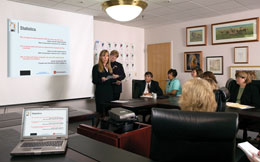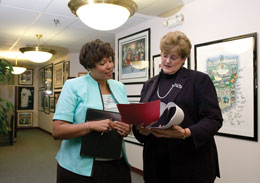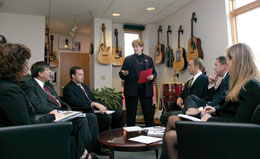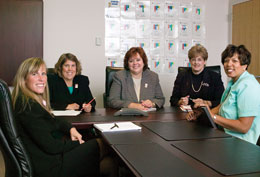|
Leading with comp
Flanders Group adds nurse to staff to help relieve workers comp pain
By Dennis H. Pillsbury
“Workers comp is the line with the most pain,” says Chris McVicker, Chairman/CEO of The Flanders Group (TFG), Pittsford, New York. “We had the foresight to realize that in the late ’80s and began to work with our clients to help reduce some of that pain. Since most agents traditionally did not attend to that area, it really gave us a competitive advantage. We have continued to lead with comp as part of our crevice marketing strategy.” (The Flanders Group focuses on niches within niches, or “crevices,” and develops unique programs for those crevices.)
The Flanders Group clients are organized in homogeneous safety groups, which are permitted in New York, where the emphasis is on reducing or eliminating losses and mitigating claims that do occur. “We have always focused on service and driving down the costs of coverage by driving down losses,” Chris adds. “Each year, we have taken our expertise to another level so that we were always one step ahead of the competition. Beginning in 1993, we brought in Risk Management Planning Group, a third-party administrator, to provide oversight of our workers comp program, so we could concentrate on our safety groups’ growth. My hard-working farmer father used to say: ‘You have to make hay while the sun shines.’”
Heather Dougherty, president—TFG Workers Compensation Division, continues: “Effective risk management always requires an absolute buy-in of senior management. Safety programs work only if they start at the top. We provide services like supervisor training—monitoring of claim reporting lag time and return-to-work strategies, including employer weekly calls to see how he or she is doing; help with safety manuals, and so on. But none of this really works unless senior management is involved.
“We constantly emphasized that need, but some clients never fully cooperated,” Heather continues. “So, in 2000, we raised the bar again and ‘fired’ customers generating $677,000 in revenue, not in premium. These were decent- to large-sized accounts that had identified themselves as not doing what was necessary to improve their losses, so we went to them and told them to look elsewhere for coverage. This was real painful to our revenue, but had to be done.”
“We work too hard to retain good clients to permit continuation with those who aren’t willing to work with us,” Chris states emphatically. “We write a little over $67 million in premium, much of it comp, and we cannot afford to jeopardize the vast number of good accounts that cooperate with our efforts. As Mr. Spock said: ‘The needs of the many outweigh the needs of the few.’ Inclusion in our safety groups is a privilege and we’re relentlessly attentive to preserving our competitive advantage.
“The comp has provided an entrée into other coverages,” explains Chris. “We write most of the ancillary coverages for our accounts because they appreciate the continuity and the ‘Quick, Kind, and Correct’ service we provide as an indelible part of TFG culture. It has enabled us to be in the top 1% in our industry, measured by high revenue per employee.”
Valarie Webster, vice president/agency relations, has been instrumental in following through on the workers comp initiatives and determining new steps that could be taken to continually improve service.
“We’re past the refinement point where we can take big self-improvement bites,” Chris explains. “It’s little bites now, but they can have a significant impact. Vilfredo Pareto’s 80/20 rule prevails, as we now have to expend 80% of our efforts to gain, in small increments, 20% of the results. Val measures the areas where we can continue to improve on the positive results we’ve already achieved.”
Over the course of the last year, Val says, “We started a new initiative which involved advising clients to make regular contact with people who were out on lost time. I looked at every open lost time case and started working them. It went really well. We started chipping away at the culture of just forgetting about injured workers. There were many psychosocial problems that these people began to experience the longer they were away from work and staying home watching Oprah and listening to attorney commercials.
“As I worked on this project, however, it became clear that we needed medical expertise to deal effectively and medically with some of the treatment circumstances that arose with specific body part injuries. We decided to hire a nurse case manager as the next step in improving our workers comp services to our clients,” Val continues.
“The person we were looking for needed to be experienced in occupational medicine, needed to have excellent relationship skills, and needed to mesh with The Flanders Group culture,” Val explains. “So, clearly, the selection process was extremely important.
“We’re associated with the Institute of Workers Comp Professionals,” she continues. “We talked to Linda Rees-Murray, RN, CWCA, SPHR, of that group about our need and she worked with us to develop an electronic interview that helped with the initial screening process. We had 56 resumes to review. That was pared down to 30 who then went through an e-interview with us. That brought the number of candidates down to 14 and we interviewed each of them. That process took more than half a year. Ultimately, we hired Beth Malone, RN, BSN, CCM, who has 30 years’ experience as a nurse.”
Chris adds, “If you think about the process, it becomes obvious why a medical professional is needed. For example, if you’re injured on the job, you go to an emergency room and then are sent home and advised to call a specialist. The claims adjuster will advise you to go online and look for a doctor nearby, as we cannot direct care in New York State. While you’re looking, it’s easy to also look for an attorney, because you’re already a little ticked off about the lack of help you’re getting. And it doesn’t stop there.
“There is a constant adversarial relationship that develops between the claims adjuster and claimant’s empathetic medical provider,” Chris continues. “The adjuster just wants the facts and the medical people can become uncooperative because of the demand for information. Having our nurse case manager mediate this exchange from the beginning can short-circuit the system to the benefit of the injured worker, the employer and the insurance company.”
Val continues, “As we went through the selection criteria, we began to realize that we were looking for a combination that was very difficult. As I worked through the workflow that our nurse would be involved in, a light bulb went off. We needed two people—the nurse and an administrative partner who could work with the nurse and help with follow-up, particularly with medical-only cases that require constant follow through. So we also hired Gerri Moretter, whose background was in communication and organization.
“We’ve already had some incredible experiences,” Val says only six weeks after bringing the nurse and her administrative partner on board. “Injured workers are confused and appreciative of anything that can be done to help them. We had 68 lost time cases that needed follow-up. Only one case went to an attorney, who was a family friend. This is a remarkable statistic.
“We’re getting terrific cooperation from the medical providers because they are talking to a peer, our nurse, who understands their problems and concerns. It’s all in the way it’s presented. We’ve had adjusters who are so thankful, workers and family members call and thank us, and it’s unbelievable and extremely rewarding from a humanitarian perspective. But it’s also rewarding for our clients,” according to Val.
“When we call an injured worker and help him or her with any problem, it’s amazing how fast word of that travels around the organization,” Val continues. “Employees see that the employer really does care about them. It’s a morale booster and everyone knows that excellent morale equates to less lost time and even to fewer accidents.”
Val concludes, “This is extremely time consuming, but the positive impact for our insureds is already beginning to show. Things can go bad very quickly, so rapid intervention is imperative. Injured workers are getting back to work faster, morale within the client organizations is improving, and almost every day, we get calls from people who are very grateful. We’ve already decided to hire another nurse and administrative person. This is definitely an area where insurance agencies can make an enormous impact.”
Chris says, “We have a saying around here: ‘If it was easy, everybody’d be doing it.’ Well, it’s not easy. But it works and we have loyal clients to show for it. Part of our job is to make it easy for our clients and if we have to work hard to do that, that’s exactly what we do. The other part of our job is livelihood, and our expertise prompts our sales team to have workers comp programs that are providing attractive, up-front discounts and a stable and sizable dividend history.” * |
|
Click on image for enlargement |
 |
| |
Heather Dougherty (above left), President, Workers Compensation Division, and Beth Malone, RN, BSN, CCM, Nurse Case Manager, discuss injury management with other members of The Flanders Group. |
| |
 |
| |
Gerri Moretter (left), Workers Compensation Case Management Specialist, and Beth Malone discuss ways to handle an open lost time case. |
| |
 |
| |
Beth Malone, surrounded by guitars and other musical instruments that are part of Chairman/CEO Chris McVicker’s collection, meets with TFG producers to discuss ways to improve workers comp results for its clients. |
| |
 |
| |
From left: Heather Dougherty, Nancy Dehm, President/COO, Valarie Webster, Vice President/Agency Relations, Beth Malone, and Gerri Moretter. |
|


